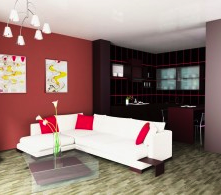Just add colour

Grey days of winter getting you down? It may be a good time to change things round by creating a multi-colour paint scheme using three or four different colours in the same room.
Paint and colour expert Debbie Zimmer from the Paint Quality Institute, says that if you want to tackle this project, you need to look at the room’s wall space in a whole new light. She suggests that you look at your walls as large, empty canvasses that may have several components.
For example, if there are chair rails in the room, they produce two separate “canvasses” on every wall (above and below the rail), doubling the room’s colour potential. Are there half walls? An alcove? A picture rail? These and other architectural elements present opportunities to introduce additional colours into the space and every one of these surfaces should be taken into account when creating a colour plan.
According to Zimmer, multi-colour paint schemes look best when a predominant colour is employed to hold things together. To that end, you should start to develop a colour palette by selecting a hue that you really love as the room’s “anchor” colour.
The next steps are to determine the paint colours you’ll use to complement or contrast with your anchor colour, and then decide where the various colours will be used.
If this is your first foray into the world of multi-colour paint schemes, it’s wise to trust the judgment of professional colourists who create paint palettes for a living. Nearly every paint manufacturer offers free brochures showing professionally created, carefully coordinated colour palettes comprised of several hues that go together beautifully. Choose a palette of harmonious tints and shades that include your anchor colour and you won’t go wrong.
There are a few different ways to decide which colour goes where:
You can simply cut out colour cards and tape samples to the walls. In doing so, be sure to place the cards close together where one colour will abut another, and view everything both in daylight and under artificial light at night (different lighting conditions can alter colours dramatically). Experiment until you’re completely happy with your plan.
Another way to map out a multi-colour paint scheme is to rely on a colour visualiser, which may be available either at the paint store or on the paint manufacturer’s website. Using this special software, you’ll be able to move colours here and there with just a couple of keystrokes until you get things exactly the way you want them.
A third way to go about developing a multi-colour paint scheme is to purchase small samples of paint, and brush colour swatches right onto the walls. This takes a little more effort, but it will make your decision-making virtually foolproof.
Whichever method you use to create your colour plan, make sure that your anchor colour is the predominant hue, taking up perhaps 40 per cent of the total wall space.
A secondary colour should take up roughly 25 per cent of the wall space, and any other colours you use should be confined to smaller areas where they’ll serve as accents.